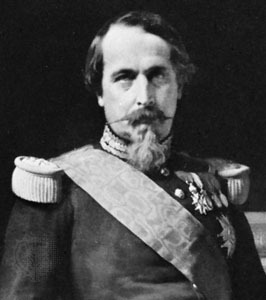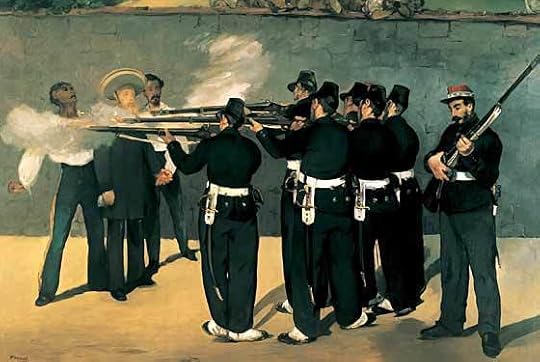Art Lovers discussion
Art History
>
Art Trivia of the Day (2011: January through March)
message 51:
by
Carol
(new)
Mar 04, 2011 06:27PM
 I love my mac . . . desktop and iPad.
I love my mac . . . desktop and iPad.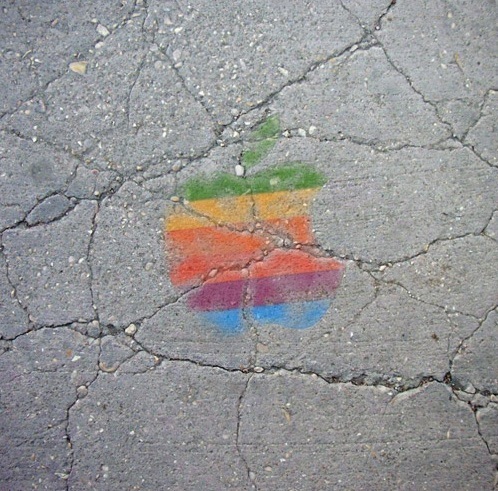
reply
|
flag
 Happy birthday to Giovanni Battista Tiepolo born March 5, 1696 in Venice, Italy.
Happy birthday to Giovanni Battista Tiepolo born March 5, 1696 in Venice, Italy.Italian painter and etcher. In the 1730s and '40s the Venetian clergy and nobility vied for his works. In 1750 he went to Würzburg with his sons and collaborators, Giovanni Domenico Tiepolo and Lorenzo Tiepolo, to decorate the prince-archbishop's palace. His Würzburg frescoes and canvases are his most boldly luminous works.
[image error]
[image error]
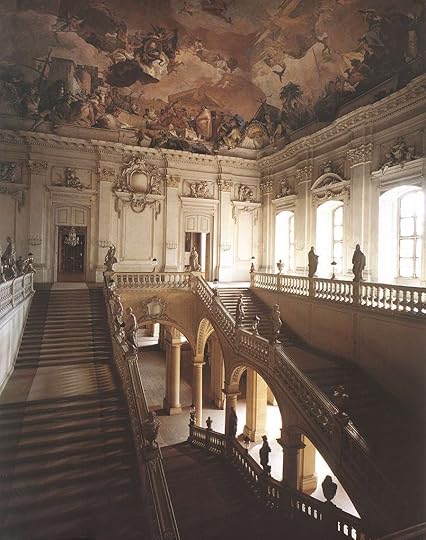
Staircase and Tiepolo ceiling fresco, Residenz, Wurzburg, Germany
[image error]
In 1762 he escaped the political disequilibrium of the Seven Years' War by accepting an invitation to paint ceilings in the royal palace in Madrid, again with his sons, his last great undertaking; he remained in Spain until his death (March 27, 1770). Although he initially used a melancholic chiaroscuro style, his later work is full of bright color and bold brushwork. His luminous, poetic frescoes both extend the tradition of Baroque ceiling decoration and epitomize Rococo lightness and elegance. (www.answers.com)
[image error]
The Apotheosis of Spain, Giovanni Battista Tiepolo, 1764, Fresco, Royal Palace, Madrid
[image error]
The Immaculate Conception, 1769
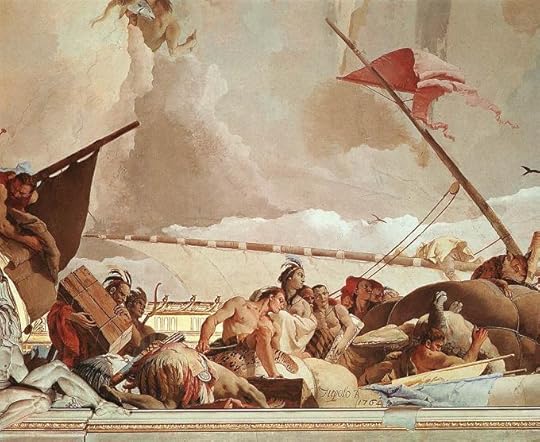
America, detail of Glory of Spain, 1766

Three angels appearing to Abraham, 1729
http://www.artinthepicture.com/artist...
 Carol wrote: "I love my mac . . . desktop and iPad.
Carol wrote: "I love my mac . . . desktop and iPad."
Me, too: '97 Power Tower Pro, a clone that came with bundled software and got Mac to get revamp their pricing/bundling..., G3, G4, 24in. iMac, 13 MacBook...love every one of 'em
But they DO present challenges with android!
 Carol wrote: "Happy birthday to Giovanni Battista Tiepolo born March 5, 1696 in Venice, Italy.
Carol wrote: "Happy birthday to Giovanni Battista Tiepolo born March 5, 1696 in Venice, Italy.Italian painter and etcher. In the 1730s and '40s the Venetian clergy and nobility vied for his works. In 1750 he w..."
I've held a cursory appreciation of Tiepolo, but now, with your introduction to his work in Germany and Spain, I have a new love.
 Happy belated birthday to Michelangelo di Lodovico Buonarroti Simoni on March 6, 1475 in Caprese, Italy.
Happy belated birthday to Michelangelo di Lodovico Buonarroti Simoni on March 6, 1475 in Caprese, Italy.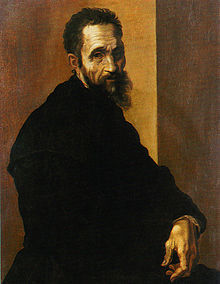
Perhaps the greatest influence on western art in the last five centuries, Michelangelo was an Italian sculptor, architect, painter and poet in the period known as the High Renaissance. His great works were almost entirely in the service of the Catholic Church, and include a huge statue of the biblical hero David (over 14 feet tall) in Florence, sculpted between 1501 and 1504 (Michelangelo's David was sculpted during almost the same years that da Vinci was painting the Mona Lisa) and the ceiling of the Sistine Chapel in Rome (commissioned by Pope Julius II), painted between 1508 and 1512. After 1519 Michelangelo was increasingly active in architecture; he designed the dome of St. Peter's Basilica, completed after his death. Along with contemporaries Leonardo da Vinci and Raphael, he is considered one of the great masters of European art. He died on February 18, 1564. (– answers.com)
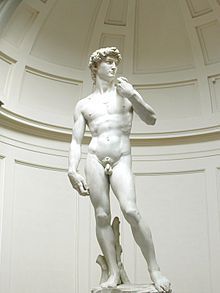
[image error]
Statue of David, 1504
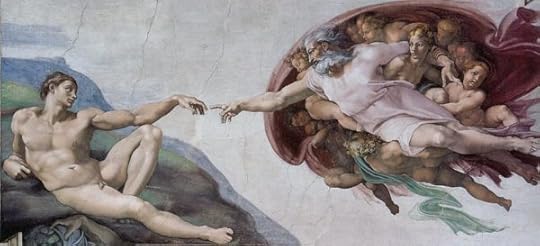
Creation of Adam
[image error]
Pieta
http://www.michelangelo-gallery.org/
 Happy belated birthday to Piet Mondrian on March 7, 1872 in Amersfoort, Netherlands.
Happy belated birthday to Piet Mondrian on March 7, 1872 in Amersfoort, Netherlands.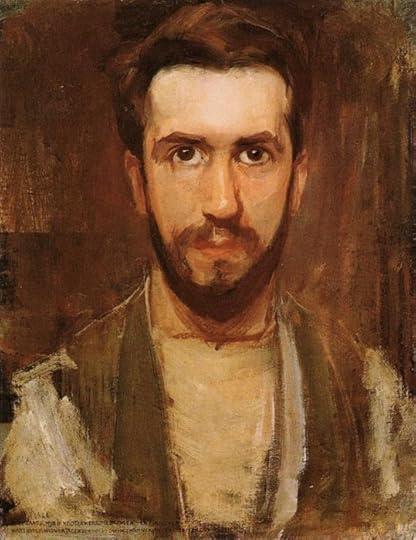
Piet Mondrian was a 20th century abstract painter whose most famous compositions are made up of black lines and colored rectangles. Mondrian's early works were naturalistic and impressionistic landscapes, but his discovery of cubism around 1910 put him on the path toward pure abstraction. He left his home in the Netherlands for Paris in 1912, but returned to the Netherlands in 1914 to care for his sick father. He remained there during World War I, exploring abstract forms and formulating an approach he called neo-plasticism. Back in Paris after the war, he made what may be his most famous painting, Composition with Red, Yellow and Blue (1921), a composition of primary colors in rectangles on a grid of black lines. In 1938 he went to England and in 1940 he moved to New York, where he continued to discard "non-essentials" and restrict his works to "basic forms of beauty." Influenced by the philosophical approach of theosophy, Mondrian believed painting to be a two-dimensional interpretation of nature that is guided by the artist's intuition. His paintings include Still Life with Ginger Pot I (1911), Composition (1916) and Broadway Boogie Woogie (1942-43). He died on February 1, 1944. (– answers.com)
[image error]
[image error]
early landscape
[image error]
Composition with Red, Yellow and Blue (1921)
[image error]
Broadway Boogie-Woogie. 1942-43. Oil on canvas, 50 x 50"(127x127 cm). The Museum of Modern Art
[image error]
Composition A: Composition with Black, Red, Gray, Yellow, and Blue, 1920, Oil on canvas, Galleria Nazionale d'Arte Moderna e Contemporanea, Rome
 Happy belated birthday to Milton Avery on March 7, 1893 in Altmar, NY.
Happy belated birthday to Milton Avery on March 7, 1893 in Altmar, NY.[image error]
American painter and printmaker. He spent his childhood in Hartford, CT, where he remained until 1925, attending art school from 1911 to 1919 and thereafter painting in the surrounding countryside. His works from this period are characterized by shiny, enamel-like surfaces, created by applying colors with brushes and a palette knife and blending them with his fingers.
After moving to New York in 1925 and his marriage, he replaced the light-drenched palette of his Hartford paintings with sombre tones. He also stopped using an impastoed, palette-knife technique and began to brush pigment on to his canvases in thin layers. His figurative and genre subjects resembled those of the realists, but his technique of dispensing with illusionistically modelled shapes in favour of simplified forms and flat colours derived from European artists such as Matisse and Picasso. During the 1930s, this simplification of form, coupled with Avery's luminous color harmonies, provided a model for a group of younger artists including Adolph Gottlieb and Mark Rothko. He also had the support of the Valentine Gallery from 1935 to 1943 and of the Paul Rosenberg Gallery from 1943 to 1950. He died on January 3, 1965. (– answers.com)
[image error]
Green Sea, 1958
[image error]
Walker by the Sea, 1961, oil on canvas, 24 x 18 inches. Neuberger Museum of Art
[image error]
Three Friends, 1944, oil on canvas, 36 x 42 inches. Neuberger Museum of Art
[image error]
white moon, 1957
 Carol wrote: "Happy belated birthday to Piet Mondrian on March 7, 1872 in Amersfoort, Netherlands."
Carol wrote: "Happy belated birthday to Piet Mondrian on March 7, 1872 in Amersfoort, Netherlands."I used to have a wonderful series of slides which showed PM's progression from fairly realistic trees, to stylized trees, to the color blocks he's famous for.
I even thought I should scan those slides now, so I could show you. But, alas. When I moved to a smaller house 4 years ago, I donated all my teaching slides (some 1500) to a local college.
 Ruth, that must have been great to see -- how lucky those art teachers are to receive your slides! I was not familiar with his early works which I find interesting.
Ruth, that must have been great to see -- how lucky those art teachers are to receive your slides! I was not familiar with his early works which I find interesting.
 Ruth wrote: I used to have a wonderful series of slides which showed PM's progression from fairly realistic ..."
Ruth wrote: I used to have a wonderful series of slides which showed PM's progression from fairly realistic ..."That would have been incredible, Ruth. Too bad they aren't available now!
 I think they stored them and will eventually ditch them. Slides are old technology now. I had trouble even finding a school that wanted them. And digitizing them would be more work than just finding stuff on the internet, I would think.
I think they stored them and will eventually ditch them. Slides are old technology now. I had trouble even finding a school that wanted them. And digitizing them would be more work than just finding stuff on the internet, I would think.
 Heather wrote: "Born on 23 January 1832: Edouard Manet French Realist Impressionist painter and printmaker who died on 30 April 1883.
Heather wrote: "Born on 23 January 1832: Edouard Manet French Realist Impressionist painter and printmaker who died on 30 April 1883.Henri Fantin-Latour's Portrait of Manet
Born into a prosperous middle-class ..."
Wow, you guys really put some work into those postings. Many of the artists you just posted (Manet, Cezanne, Morisot, etc.) feature prominently in a book I am reading, The Judgement of Paris, seems like a spooky coincidence. By the way, there was an additional scandal I learned about in the book, about the Manet painting of the execution of Maximilian, not only were the uniforms blue like the French, instead of grey, but the guy on the right, preparing to do the coup de gras, is a dead ringer for Napolean III. Look at a photo of him and compare!
 Happy birthday to Elaine de Kooning on March 12, 1918 in Brooklyn. NY.
Happy birthday to Elaine de Kooning on March 12, 1918 in Brooklyn. NY.[image error]
self portrait #46, oil on paper on linen
Elaine (born Elaine Marie Catherine Fried) was an Abstract Expressionist and Figurative Expressionist painter sculptor, draughtswoman, printmaker, and writer in post-World War II era. She was the wife of artist Willem de Kooning.
De Kooning studied in New York at the Leonardo da Vinci Art School, the American Art School, the Academy School, and with Willem de Kooning. She was interested in both figurative and abstract art, acknowledging the influence of her husband and of the Abstract Expressionists of the New York School. Elaine met Willem de Kooning in 1938 and the couple married in 1943. They had a turbulent marriage, separating in 1956 and reconciling in 1975. Though they benefited from one another’s art and teaching, they also suffered from each other’s infidelities and struggles with alcoholism.
[image error]
early photo of Willem and Elaine de Kooning
[image error]
Elaine and Willem de Kooning in his improvised studio on Leo Castelli's porch, 1953
During the 1940s, de Kooning painted portraits of her family, her husband, and many of her literary friends and fellow artists, including the poets Frank O’Hara and Allen Ginsberg and the choreographer Merce Cunningham.
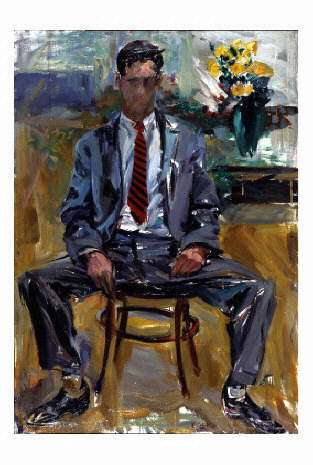
[image error]
rocks on a hill
[image error]
Veronica, 1960, Bauer Museum of Art.
[image error]
Bull, 1958, Oil on canvas, Grey Art Gallery, New York University Art Collection
De Kooning had her first solo exhibition at the Stable Gallery in New York in 1952 and exhibited almost annually thereafter throughout the United States, including shows at the Pennsylvania Academy of the Fine Arts, Philadelphia, and Washington Gallery of Modern Art in 1964.
In 1962, de Kooning was commissioned by the White House to paint the portrait of President John F. Kennedy. The portrait is one of de Kooning’s most well known and celebrated paintings. Following his assassination in 1963, de Kooning stopped painting for a year and took a teaching appointment at the University of California, Davis.
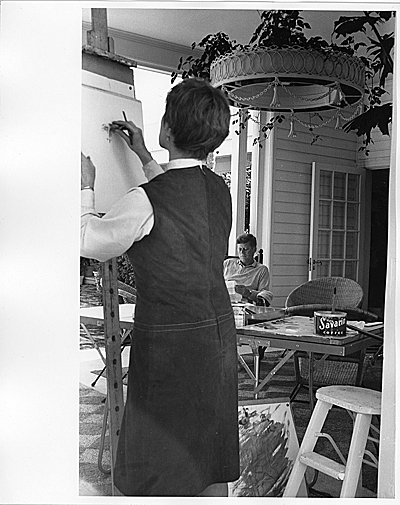
photograph of Elaine de Kooning sketching JFK in Dec. 1962
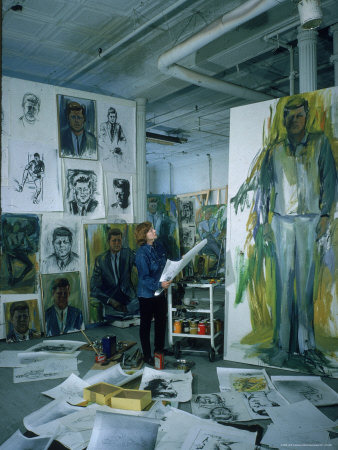
Elaine de Kooning working on JFK in her Manhattan studio, 1964
[image error]
Portrait of JFK
In the 1970s, de Kooning taught at numerous colleges including Yale University, Pratt Institute, University of Pennsylvania, and Rice University, and others. While de Kooning, like the “action” painters of the time, used gestural brushstrokes, most her work was figurative and representational, and rarely pure abstraction. An avid traveler, “she was exposed to and inspired by a wide variety of art work that helped make her one of the more diverse artists from the Abstract Expressionist movement; she experimented with sculpture, etchings and subject matter inspired by cave drawings, all in addition to her wealth of painting, which included everything from watercolors and still lifes to abstractions and formal portraits.”
[image error]
later photo of Willem and Elaine de Kooning
De Kooning’s works are in the collections of numerous major American museums, including the Guggenheim, the Museum of Modern Art in New York, the Corcoran Gallery in Washington, DC, and the Albright-Knox Gallery in Buffalo, New York.
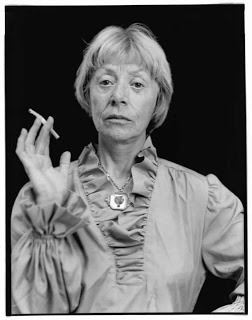
Elaine de Kooning died of lung cancer on February 1, 1989. Willem de Kooning, suffering from dementia at the time, was never told of his wife’s death. (artfixx.com)
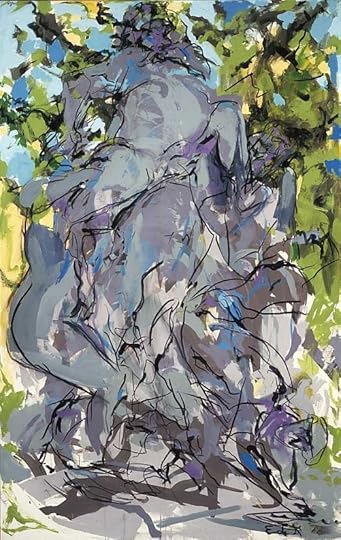
[image error]
 Thanks, Carol. I didn't know much about Elaine, actually, nothing at all. Seeing the works that you posted here, I think I like her work better than her husband's, Willem de Kooning. I don't know, I'd have to see both in person. When I ever get to the east coast...!
Thanks, Carol. I didn't know much about Elaine, actually, nothing at all. Seeing the works that you posted here, I think I like her work better than her husband's, Willem de Kooning. I don't know, I'd have to see both in person. When I ever get to the east coast...!
 I have never seen her work in person but I love her colors and her brushwork. I put a few books about her on the bookshelf.
I have never seen her work in person but I love her colors and her brushwork. I put a few books about her on the bookshelf.
 Thanks for telling us about Elaine de Kooning. She was a wonderful painter and very pretty, too. I had no idea the White house commissioned her to paint JFK, a radical choice, imo. Of the works posted, Veronica and Rocks on a Hill are my faves.
Thanks for telling us about Elaine de Kooning. She was a wonderful painter and very pretty, too. I had no idea the White house commissioned her to paint JFK, a radical choice, imo. Of the works posted, Veronica and Rocks on a Hill are my faves.
 Thanks Carol for that information about Elaine. Facinating and the sheer size of that JFK painting! Really have to agree w/Heather, I think I like her pieces better than her husbands!
Thanks Carol for that information about Elaine. Facinating and the sheer size of that JFK painting! Really have to agree w/Heather, I think I like her pieces better than her husbands!
 Does anyone know why Elaine is given such a minor billing compared to her husband Willem when her work is so alive?
Does anyone know why Elaine is given such a minor billing compared to her husband Willem when her work is so alive?
 Jim wrote: "Does anyone know why Elaine is given such a minor billing compared to her husband Willem when her work is so alive?"
Jim wrote: "Does anyone know why Elaine is given such a minor billing compared to her husband Willem when her work is so alive?"T'was ever so.
 I can't say I agree with Ruth's answer in light of all the exposure women artist's have and have had for some time.
I can't say I agree with Ruth's answer in light of all the exposure women artist's have and have had for some time. I don't know when women artists began receiving equal attention in the art world but I know at The Wexner Center for the Contemporary Arts where I docent, women artists are definitely exhibited as much as men artists.
and so maybe it "T'was ever so" but I don't see that being the case now and for some time during the 20th century.
 Maybe she wasn't as ambitious as he was. Or maybe she saw her role as a woman in a more traditional way, but was also an artist. Do I recall that in both the photos of the pair, she placed herself behind him?
Maybe she wasn't as ambitious as he was. Or maybe she saw her role as a woman in a more traditional way, but was also an artist. Do I recall that in both the photos of the pair, she placed herself behind him?
 You're right, Jim, in that women artists get much more exposure now than they used to. But that's relatively recent. During the days of the Abstract Expressionists the art world was a man's world. Lee Krasner didn't get any attention either.
You're right, Jim, in that women artists get much more exposure now than they used to. But that's relatively recent. During the days of the Abstract Expressionists the art world was a man's world. Lee Krasner didn't get any attention either.
 Not to get us totally off track, but the National Museum of Women in the Arts in D.C. is a treasure trove of famous, but mostly overlooked female artists. http://www.nmwa.org/
Not to get us totally off track, but the National Museum of Women in the Arts in D.C. is a treasure trove of famous, but mostly overlooked female artists. http://www.nmwa.org/
 Thanks for introducing that, Lorie! Someday I would love to visit that, too. Of course, where would I NOT want to go???
Thanks for introducing that, Lorie! Someday I would love to visit that, too. Of course, where would I NOT want to go???
 Oh I definitely will, Monica! That would be so incredible! In fact, I have a $300 voucher to use before August. I hope to go to NY with it. I will let you know!
Oh I definitely will, Monica! That would be so incredible! In fact, I have a $300 voucher to use before August. I hope to go to NY with it. I will let you know!
 I have mixed feelings about the National Museum of Women in the Arts. On the one hand, I'm happy to see more women getting attention.
I have mixed feelings about the National Museum of Women in the Arts. On the one hand, I'm happy to see more women getting attention.On the other hand, I'd rather we be getting attention in the regular galleries and museums instead of being ghettoized.
 Have you been Ruth? It's really beautiful. I see your point, although 'ghetto' is maybe harsh. I don't know, there is an American Indian Museum, Textile Museum, African Amercian Gallery, etc.. all just here in DC, I look at it more as yet another place for art, albeit specialized, which here in DC, is a miracle in itself.
Have you been Ruth? It's really beautiful. I see your point, although 'ghetto' is maybe harsh. I don't know, there is an American Indian Museum, Textile Museum, African Amercian Gallery, etc.. all just here in DC, I look at it more as yet another place for art, albeit specialized, which here in DC, is a miracle in itself.I did notice while walking through the Virginia Museum of Fine Art in Richmond last week, in the "New Acquisitons" section, at least 1/2 of the pieces were female artists.. that's something.
 I know, Lorie.That's what accounts for my mixed feelings. And I agree, "ghetto" was a little strong. But still, I look forward to the day when women, American Indians, African Americans and others are included in museums because of what their art is, and not because of who they are.
I know, Lorie.That's what accounts for my mixed feelings. And I agree, "ghetto" was a little strong. But still, I look forward to the day when women, American Indians, African Americans and others are included in museums because of what their art is, and not because of who they are.
 Ruth said: "...when women, American Indians, African Americans and others are included in museums because of what their art is, and not because of who they are.
Ruth said: "...when women, American Indians, African Americans and others are included in museums because of what their art is, and not because of who they are.I completely agree, Ruth. I happen to agree with that on many levels stretched to other seeming injustices in America these days, which I won't go into here.
 Thanks Divvy. Elaine de Kooning's artwork is really outstanding. I put a 2 books on the bookshelf --
Thanks Divvy. Elaine de Kooning's artwork is really outstanding. I put a 2 books on the bookshelf --
 Happy belated birthday to William James Glackens born on March 13, 1870 in Philadelphia, PA .
Happy belated birthday to William James Glackens born on March 13, 1870 in Philadelphia, PA .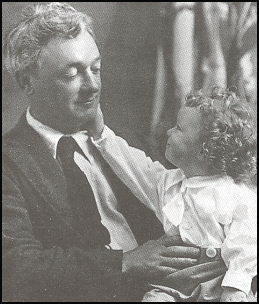
William and Lenna Glackens in 1914
Glackens was an American realist painter. He studied at the Pennsylvania Academy of the Fine Arts and later moved to New York City, where he co-founded what came to be called the Ashcan School art movement. This group of artists, dubbed by the press "the Eight Independent Painters" or The Eight, chose to exhibit their works without pre-approval by the juries of the existing art establishment. He became known for his dark-hued paintings of street scenes and daily life in the city's neighborhoods. His later work was brighter in tone, and showed the influence of Renoir. In 1913 he helped organize and exhibited in the Armory Show. Glackens died May 22, 1938, Westport, CT.
[image error]
Ashcan School artists & friends at John French Sloan's Philadelphia Studio, 1898

Shop Girls, ca. 1900, Pastel and watercolor on illustration board, 13 5/8 x 14 3/8 in, The Metropolitan Museum of Art, detail below

[image error]
Hammerstein’s Roof Garden, c. 1901. Oil on canvas, 30 × 25 in., Whitney Museum of American Art, New York
[image error]
East River Park, oil on canvas, c. 1902; Brooklyn Museum, New York.
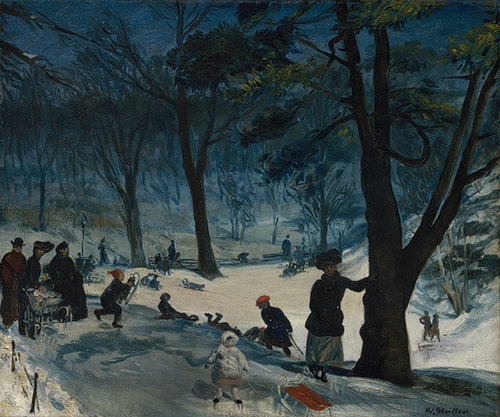
Central Park, Winter, ca. 1905, oil on canvas, 25 x 30 in., The Metropolitan Museum of Art, below detail of painting
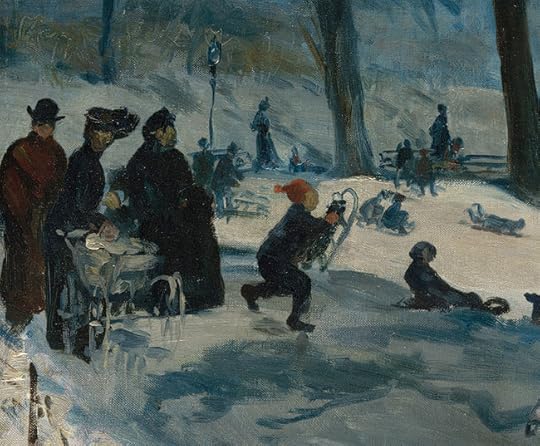
Glackens portrays a group of well-behaved children sledding down a gentle slope in New York's Central Park under the watchful eyes of adults who dot the perimeter of a snowy knoll. The children are warmly dressed and the adults are fashionably clothed, signaling that this is a story of middle-class recreation. Despite their nominal commitment to telling the unvarnished truth about modern life and urban hardship, Glackens and other Ashcan artists viewed their world through rose-colored glasses, presenting the city euphemistically and, as here, depicting people at leisure in quasi-rural surroundings rather than in their overcrowded home neighborhoods.
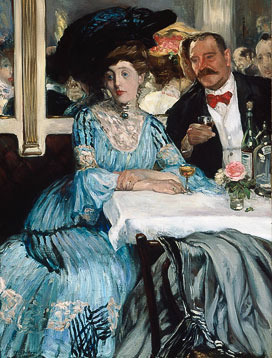
At Mouquin's, Oil on canvas, 1905, The Art Institute of Chicago
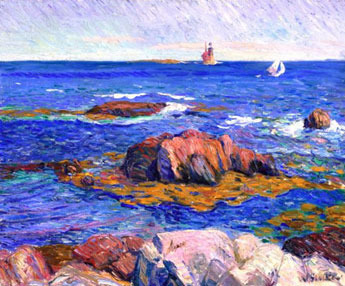
Rocks and Lighthouse, Oil on canvas, Circa 1908
[image error]
Nude with Apple, oil on canvas, 1909–10; Brooklyn Museum, New York.
[image error]
Far from the Fresh Air Farm, 1911, carbon pencil and watercolor on paper, Museum of Art, Fort Lauderdale, FL
[image error]
Italo-American Celebration, Washington Square, 1912, Boston mfa
[image error]
Natalie in a Blue Skirt, 1914, oil on canvas. Tacoma Art Museum.
 Happy belated birthday to Georges de la Tour born on March 13, 1593.
Happy belated birthday to Georges de la Tour born on March 13, 1593.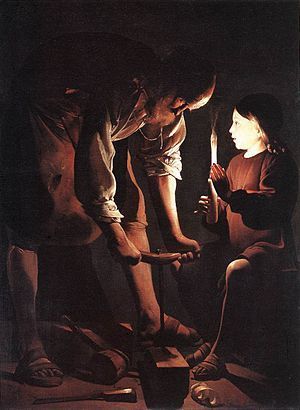
St. Joseph, 1642, Louvre
He was well known in his lifetime, especially for his depictions of candlelit subjects, then was forgotten until the 20th century, when the identification of works previously misattributed established his reputation as a giant of French painting. His early works were painted in a realistic manner and influenced by the dramatic chiaroscuro of Caravaggio. The paintings of La Tour's maturity are marked by a startling geometric simplification of the human form and by the depiction of interior scenes lit only by the glare of candles or torches. His religious paintings done in this manner have a monumental simplicity and a stillness that expresses both contemplative quiet and wonder. Little is known of his life, and only four or five of his paintings are dated. The chronology and authenticity of some works attributed to him are still debated. (wiki)

Saint Sebastian Tended by Irene, early 1630s
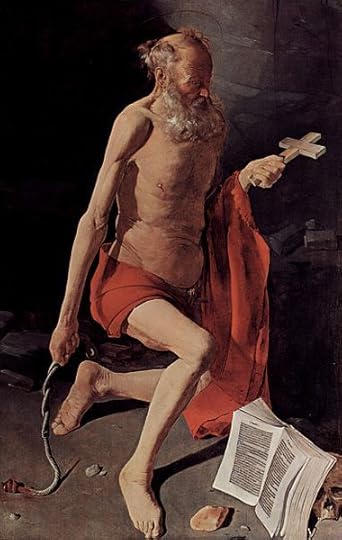
St Jerome (Hurdy-gurdy group), Museum of Grenoble
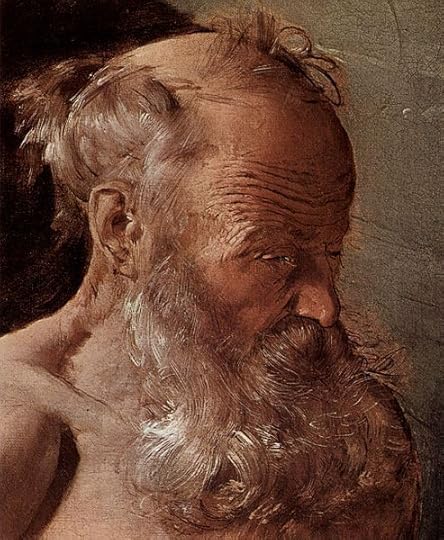
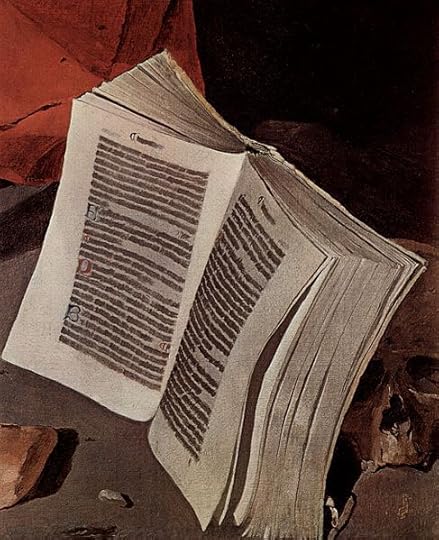
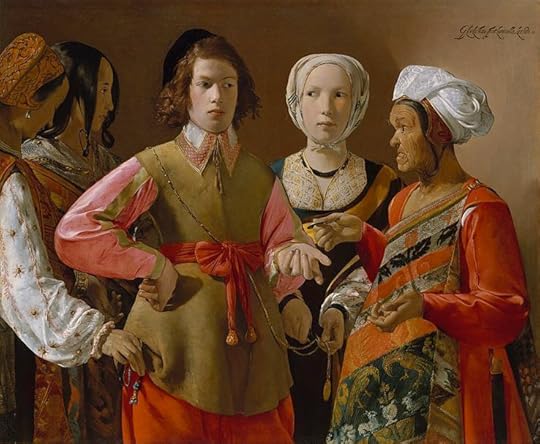
The Fortune Teller, 1633-39, oil on canvas, Metropolitan Museum of Art, detail below
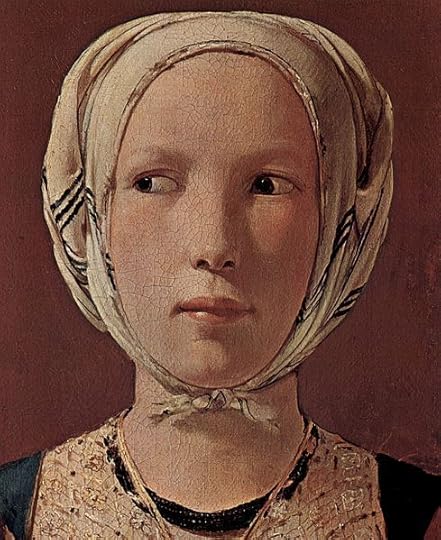
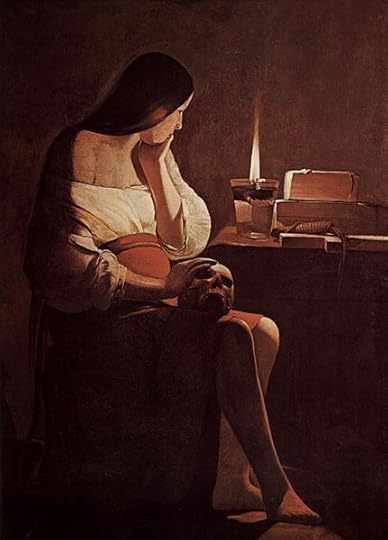
Magdalen with the Smoking Flame, ca. 1640-1645, oil on canvas, Louvre
 Happy birthday to Reginald Marsh born on March 14, 1898 in Paris, France.
Happy birthday to Reginald Marsh born on March 14, 1898 in Paris, France.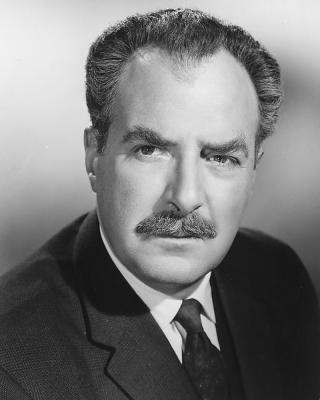
Born to American parents in Paris and educated at Yale University, from 1922 to 1925 he produced a daily column of drawings of vaudeville acts for the New York Daily News. In 1925 he became an original member of the staff of The New Yorker magazine, for which he drew humorous illustrations and metropolitan scenes. In 1929 he began painting scenes of city life, including Coney Island crowds and Bowery derelicts. He taught at the Art Students League from 1934 until his death on July 3, 1954 in Bennington, VT. (answers.com)
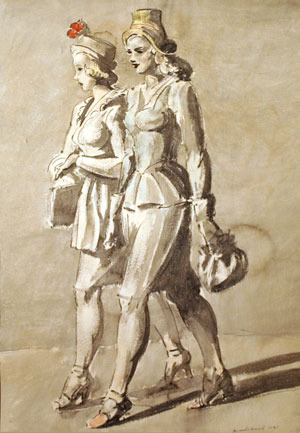
Two Girls Walking/Three Girls Standing, 1946, double-sided watercolor painting on paper,
[image error]
[image error]
[image error]
Bowery
[image error]
Couple Dancing at the Savoy”, 1934, Oil on canvas
[image error]
“The Normandie”, 1953, water color on paper”
 Happy birthday to Diane Nemerov Arbus born on March 14, 1923 in New York, NY.
Happy birthday to Diane Nemerov Arbus born on March 14, 1923 in New York, NY.[image error]
Diane Arbus was a New York photographer known for her black and white portraits of eccentrics, carnival performers and, as she put it, "freaks." The daughter of well-to-do fur merchants, she married her teenage sweetheart, Allan Arbus, soon after she turned 18. Together they had a fashion photography business for more than a decade, but in 1959 they ended their partnership and marriage and Diane began studying fine art photography. In the 1960s she worked as a photojournalist, received two Guggenheim fellowships (1963 and 1966) and received critical praise for her vaguely disturbing portraits of society's fringe members. She committed suicide on July 26, 1971 after a period of depression by taking barbituates and cutting her wrists. After her suicide, a national touring exhibit by the Museum of Modern Art and a book of her photographs by Aperture magazine made her one of the most famous fine art photographers in the U.S. (answers.com)
Her most famous photos include Child with a toy hand grenade in Central Park, N.Y.C., 1962 and Identical Twins, Roselle, N.J., 1967 seen below.
[image error]
[image error]
yesterday and today of the twins - http://www.google.com/imgres?imgurl=h...
Best known for her pictures of dwarves, transvestites, nudists and circus performers, she was a pioneer, photographing those things that the public of that era would not otherwise have seen. Though the settings appear casual, there was nothing improvisational about Arbus’ shots. She spent great amounts of time getting to know her subjects before photographing them, and they often collaborated in the picture-making process.
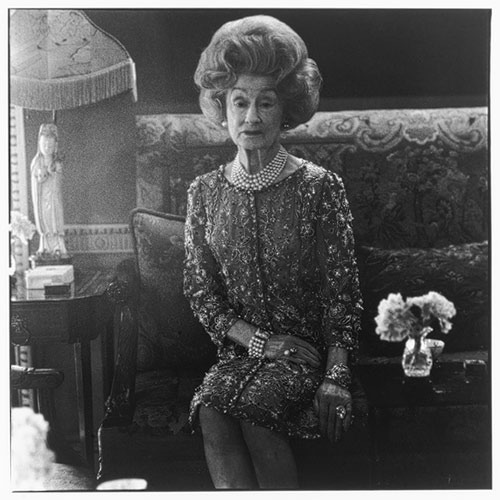
Mrs. T. Charlton Henry in her Chestnut Hill home, Philadelphia, PA., 1965, Metropolitan Museum of Art
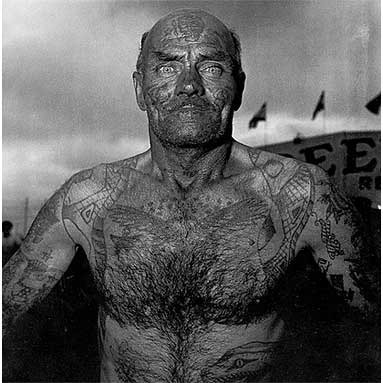
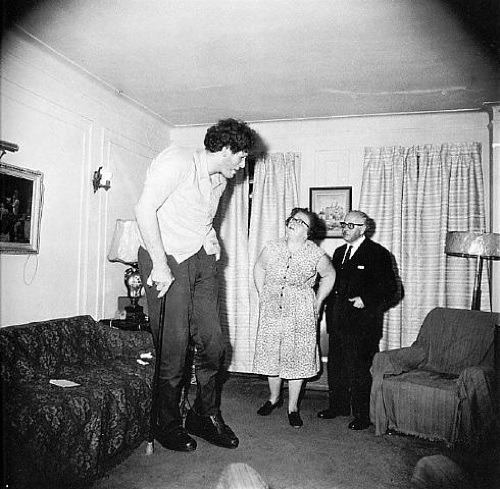
[image error]
 Happy birthday to Jennifer Bartlett born on March 14, 1941 in Long Beach, CA.
Happy birthday to Jennifer Bartlett born on March 14, 1941 in Long Beach, CA.[image error]
She is best-known for paintings combining abstract and representational styles. Bartlett attended Mills College in Oakland, California. While a student, she formed a friendship with the future mixed-media sculptor Elizabeth Murray. Bartlett received her BFA in 1963; she then traveled to New Haven to study at Yale School of Art and Architecture and received her MFA in 1965, at a time when minimalism was the dominant style. Bartlett's instructors included the artists James Rosenquist, Jim Dine, Claes Oldenburg, Robert Rauschenberg, Alex Katz, and Al Held. She is best known for her paintings and prints of mundane objects—especially houses.
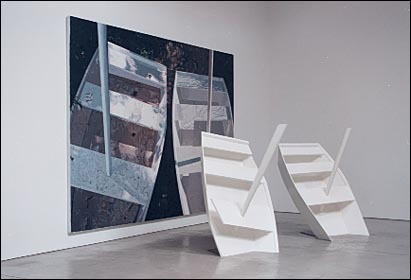
"Boats" 1987
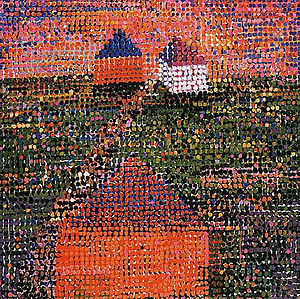
'Houses', serigraph, 2005
[image error]
October, Amagansett, No. 18, 2004, Pastel on paper, 30 x 30 inches
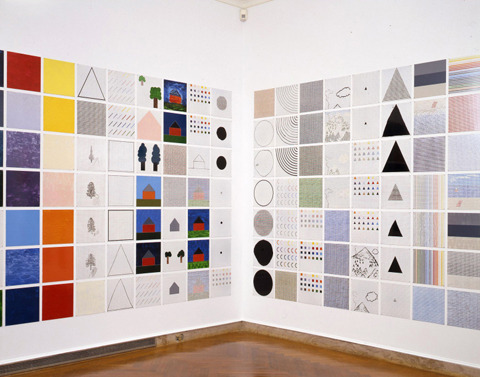
Rhapsody, installation view of Jennifer Bartlett: Early Plate Work, Addison Gallery of American Art, Fall 2006
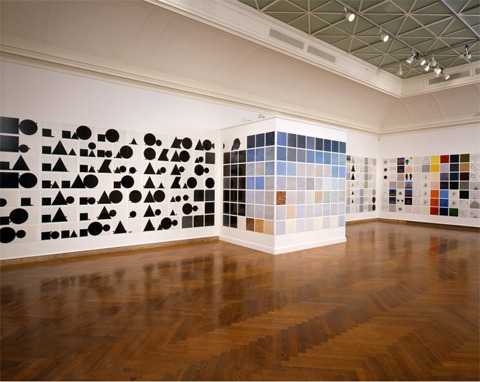
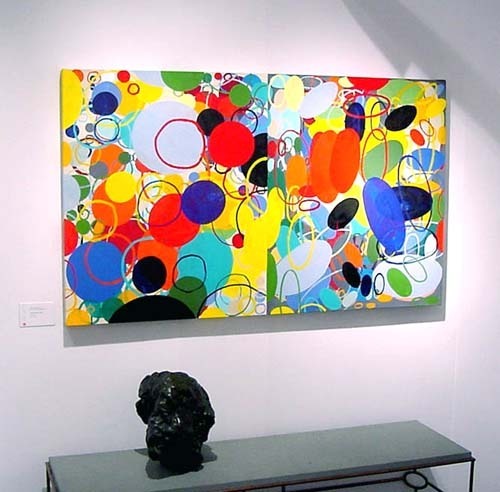
Untitled (dyptich), 2001, at Locks Gallery, Philadelphia.
 Bartlett did lots of things in different styles, quite well. I've never heard of her, thanks again Carol.
Bartlett did lots of things in different styles, quite well. I've never heard of her, thanks again Carol.Diane Arbus was quite famous even before she died.
 I think I can agree with Ruth. I had never heard of Jennifer Bartlett but looking at her above posted works, it seems that she couldn't decide on a style. That is just my impression and I am no art critic (that's for sure!).
I think I can agree with Ruth. I had never heard of Jennifer Bartlett but looking at her above posted works, it seems that she couldn't decide on a style. That is just my impression and I am no art critic (that's for sure!).
 I love Itō Jakuchū's work. I'm going to have to make a concerted effort to go to this forum more often. I'm so wrapped up in catching up with the monthly reads and discussions of my other forums.
I love Itō Jakuchū's work. I'm going to have to make a concerted effort to go to this forum more often. I'm so wrapped up in catching up with the monthly reads and discussions of my other forums.
 I guess the best way to do that is to do an instant e-mail notification as a reminder. I've digested all my forums since I have so many now.
I guess the best way to do that is to do an instant e-mail notification as a reminder. I've digested all my forums since I have so many now.


